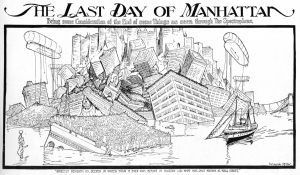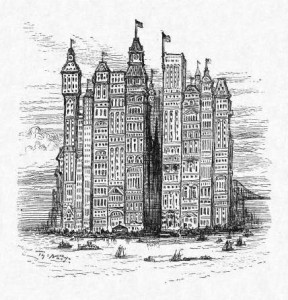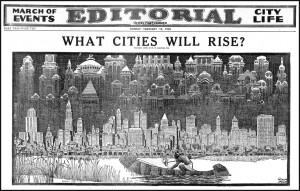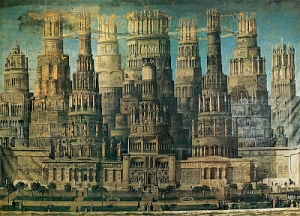Winsor McCay (1867-1934)
The Last Day of Manhattan, 1905
Illustration published in the New York Herald (Sunday February 26, 1905): Magazine Section, p. 6.
Under the title of the above illustration and below the picture are two more sentences describing what McCay’s image illustrates:
(Above) Being some Consideration of the End of some Things as seen through The Spectrophone. (Below)“Directly beneath us deeper in water than it ever was before in history likes what was once known as Wall Street.” Since the 1880s illustrators have imagined a future Manhattan so over-built as to resemble a mountain face of skyscrapers piled out to the water’s edge. Interestingly Thomas Nast’s illustration of this predated the coining of the term ‘skyscraper’ which first appeared in Harper’s Weekly in 1893. Nast’s vision of the future city is illustrated below. Thomas Nast (1840-1902) In 1928, cartoonist Winsor McCay compared his vision of Manhattan’s past when the island belonged to the Indians, to its early 20th century present, and finally to a dream of the future look of the cityscape in one image. Winsor McCay (1867-1934) McCay’s vision of the future city reminded me of Erastus Salisbury Field’s monumental 19th century painting, The Historical Monument of the American Republic. (See below) Erastus Salisbury Field (1805-1900) The John Kendrick Bangs (1862-1922) newspaper piece illustrated by McCay at the beginning of this posting, The Last Day of Manhattan,* revolves around the creation of a fantastic imaginary piece of scientific equipment, The Spectrophone. This object allowed the viewer to look ahead and see into a specific future time. Bangs was an author, editor, and satirist. He began contributing short pieces to humor magazines while he was a student at Columbia University in the early 1880s. After a short stint in law school, Bangs began his career as a magazine editor and a writer. In various newspaper installments on The Spectrophone accompanied by McCay illustrations, Bangs chronicled how advertising had proliferated in the subway by 1907; what the public libraries of Boston and New York looked like in 1914; the state of cooking for the public in 1926; a New England society banquet in 1947 where dinner speeches were given by recordings; and the strange changes that happened to the New York Horse Show in 2263. In the very distant future as seen in The Spectrophone, Manhattan and its surrounding neighbors as far south as Washington, D.C., as far west as Chicago, and into the sky to 16,000 feet, will become one megalopolis called Philyorgo—“the commercial capital of the universe.” ** Our initial McCay cartoon is an image of the final viewing through The Spectrophone. What surprised me was how timely the image seems in the wake of the flooding and destruction left from Hurricane Sandy battering the east coast. But what McCay illustrated was not our contemporary destruction, but a distant future disaster in the 57th century when theManhattan, so over-built both above and below ground, begins to implode. “. . . what one of us would care to be on the island of Manhattan at that terrible moment when, thanks to the undermining of its foundations and the superimposition upon its surface of billions upon billions of tons of buildings, the whole thing falls in with a crash, carrying Long Island down with it and so letting in the sea upon the scenes of its former grandeurs?” *** The chronicler of the disaster noted that the thousands of survivors were flocking to safe spaces like Central Park with little excavated under it and nothing built on top of it, or the roof tops of steel framed skyscrapers as they waited for airships and steamships to retrieve them from their temporary refuges. At the end of the newspaper piece is the destruction of The Spectrophone. “I shall never forget the maniacal cry of despair of Professor Forcasta as he entered the room and viewed the ruin my carelessness had caused. Over that scene at least let me draw a veil. It was an awful moment, and it suffices that you should know that the Sprectrophone is no more.” * * * * * * * “My only surprise,” said Colonel Gabster, when I narrated to him the details of the end ofManhattan, “is that it doesn’t happen until 5639.” “You expect something of the kind then?” said I. “Yes,” said he. “With our engineers burrowing deeper and deeper under the city all the time and our construction companies building higher and higher at the same time, something somewhere is bound to give way some time. If the Spectrophone had predicted it for next Tuesday I wouldn’t have bet seven cents to a million that the machine lied.”**** * Bangs’ title, The Last Day of Manhattan is a reference to Sir Edward Bulwer-Lytton’s popular work of historical fiction The Last Days of Pompeii, published in 1834 about the cataclysmic destruction of the city of Pompeii in 79 AD by the eruption of Mount Vesuvius. **https://cbsrfs.ucr.edu/batches/batch_ca_20070522_oasis/sn85042462/00175047359/1906030401/0097.pdf ****One of my favorite lines of this spoof refers to Augustus Saint-Gaudens’ gilded copper tower-top figure of Diana that once graced Stanford White’s Madison Square Garden complex in New York. It was uttered by a shipboard tourist guide taking curiosity seekers on a tour of the disaster: “The tall brass [sic.] figure sticking up out of the sea to the left is the Statue of Diana, marking the site of the once famous Madison Square Garden;” December 13, 2012 By Joyce K. Schiller, Curator, Rockwell Centerfor American Visual Studies, Norman Rockwell Museum
New Yorkin a Few Years from Now: View from the Bay
Harper’s Weekly, (August 27, 1881)
What Cities Will Rise?, 1928
Editorial page illustration, Herald Examiner (Sunday February 19, 1928): Part Two, p. 10.
The Historical Monument of the American Republic, 1867-88
Oil on canvas, 9’3″ x 13’1″
George Walter Vincent Smith Art Museum, Springfield, Massachusetts










